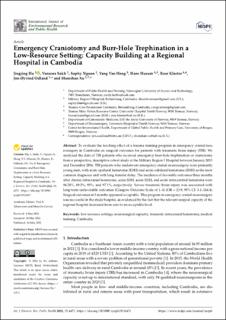| dc.contributor.author | Hu, Jingjing | |
| dc.contributor.author | Sokh, Vannara | |
| dc.contributor.author | Nguon, Sophy | |
| dc.contributor.author | Heng, Yang Van | |
| dc.contributor.author | Husum, Hans | |
| dc.contributor.author | Kloster, Roar | |
| dc.contributor.author | Odland, Jon Øyvind | |
| dc.contributor.author | Xu, Shanshan | |
| dc.date.accessioned | 2023-01-04T11:50:37Z | |
| dc.date.available | 2023-01-04T11:50:37Z | |
| dc.date.created | 2022-07-06T11:50:32Z | |
| dc.date.issued | 2022 | |
| dc.identifier.citation | International Journal of Environmental Research and Public Health (IJERPH). 2022, 19 (11), . | en_US |
| dc.identifier.issn | 1661-7827 | |
| dc.identifier.uri | https://hdl.handle.net/11250/3040910 | |
| dc.description.abstract | To evaluate the teaching effect of a trauma training program in emergency cranial neurosurgery in Cambodia on surgical outcomes for patients with traumatic brain injury (TBI). We analyzed the data of TBI patients who received emergency burr-hole trephination or craniotomy from a prospective, descriptive cohort study at the Military Region 5 Hospital between January 2015 and December 2016. TBI patients who underwent emergency cranial neurosurgery were primarily young men, with acute epidural hematoma (EDH) and acute subdural hematoma (SDH) as the most common diagnoses and with long transfer delay. The incidence of favorable outcomes three months after chronic intracranial hematoma, acute SDH, acute EDH, and acute intracerebral hematoma were 96.28%, 89.2%, 93%, and 97.1%, respectively. Severe traumatic brain injury was associated with long-term unfavorable outcomes (Glasgow Outcome Scale of 1–3) (OR = 23.9, 95% CI: 3.1–184.4). Surgical outcomes at 3 months appeared acceptable. This program in emergency cranial neurosurgery was successful in the study hospital, as evidenced by the fact that the relevant surgical capacity of the regional hospital increased from zero to an acceptable level. | en_US |
| dc.language.iso | eng | en_US |
| dc.publisher | MDPI | en_US |
| dc.rights | Navngivelse 4.0 Internasjonal | * |
| dc.rights.uri | http://creativecommons.org/licenses/by/4.0/deed.no | * |
| dc.title | Emergency Craniotomy and Burr-Hole Trephination in a Low-Resource Setting: Capacity Building at a Regional Hospital in Cambodia | en_US |
| dc.title.alternative | Emergency Craniotomy and Burr-Hole Trephination in a Low-Resource Setting: Capacity Building at a Regional Hospital in Cambodia | en_US |
| dc.type | Peer reviewed | en_US |
| dc.type | Journal article | en_US |
| dc.description.version | publishedVersion | en_US |
| dc.source.pagenumber | 12 | en_US |
| dc.source.volume | 19 | en_US |
| dc.source.journal | International Journal of Environmental Research and Public Health (IJERPH) | en_US |
| dc.source.issue | 11 | en_US |
| dc.identifier.doi | https://doi.org/10.3390/ijerph19116471 | |
| dc.identifier.cristin | 2037356 | |
| cristin.ispublished | true | |
| cristin.fulltext | original | |
| cristin.qualitycode | 1 | |

